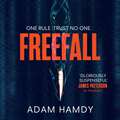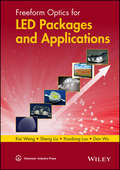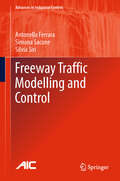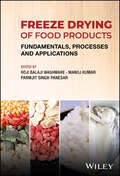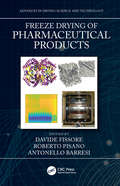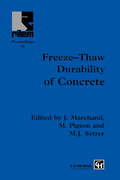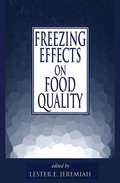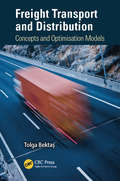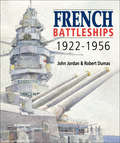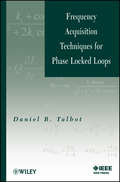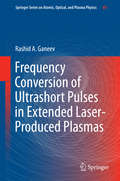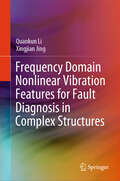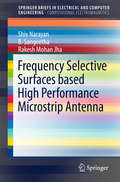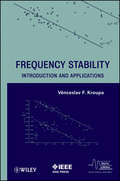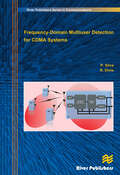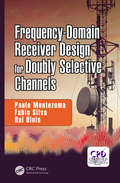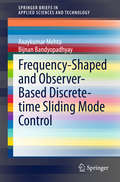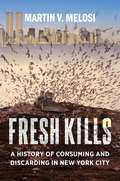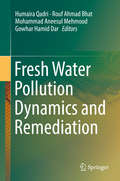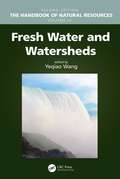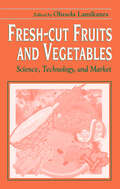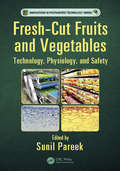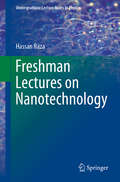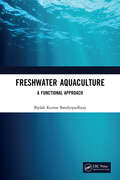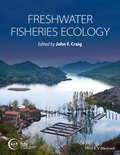- Table View
- List View
Freefall: the explosive thriller (Pendulum Series 2) (Pendulum #2)
by Adam HamdyONE RULE. TRUST NO-ONE.This explosive, pulse-racing thriller is perfect for fans of JACK REACHER and ORPHAN X, with a story as unexpected as a sniper's bullet. Adam Hamdy's first PENDULUM novel was called 'one of the best thrillers of the year' by JAMES PATTERSON.JOHN WALLACE IS A TARGETHiding off-grid after exposing the shadowy Pendulum conspiracy, Wallace is horrified to discover he is still marked for death.THERE ARE ONLY TWO PEOPLE HE CAN TRUSTDI Patrick Bailey is still reeling from the murder investigation that nearly cost him his life. FBI Agent Christine Ash is hunting a serial killer with a link to an unfinished caseHE MUST FIND THE TRUTHThe death of a London journalist triggers an investigation that brings them back together, hurling them into the path of an unknown enemy.BEFORE THE KILLER FINDS HIMHunted across the world, they are plunged into a nightmare deadlier than they could have ever imagined.'One of the best thriller writers I've read in recent years, Adam's writing is slick and unputdownable, he hooks you in from the first chapter and doesn't let you come up for air.' JENNY BLACKHURST, the #1 eBook (P)2017 Headline Publishing Group Ltd.
Freeform Optics for LED Packages and Applications
by Sheng Liu Xiaobing Luo Dan Wu Kai WangA practical introduction to state-of-the-art freeform optics design for LED packages and applications By affording designers the freedom to create complex, aspherical optical surfaces with minimal or no aberrations, freeform design transcends the constraints imposed by hundreds of years of optics design and fabrication. Combining unprecedented design freedom with precise light irradiation control, freeform optics design is also revolutionizing the design and manufacture of high quality LED lighting. The first and only book of its kind, Freeform Optics for LED Packages and Applications helps put readers at the forefront of the freeform optics revolution. Designed to function as both an authoritative review of the current state of the industry and a practical introduction to advanced optical design for LED lighting, this book makes learning and mastering freeform optics skills simpler and easier than ever before with: Real-world examples and case studies systematically describing an array of algorithms and designs—from new freeform algorithms to design methods to advanced optical designs Coding for all freeform optics algorithms covered—makes it easier and more convenient to start developing points of freeform optics and construct lenses or reflectors, right away Case studies of a range of products, including designs for a freeform optics LED bulb, an LED spotlight, LED street lights, an LED BLU, and many more Freeform Optics for LED Packages and Applications is must-reading for optical design engineers and LED researchers, as well as advanced-level students with an interest in LED lighting. It is also an indispensable working resource design practitioners within the LED lighting industry.
Freeway Traffic Modelling and Control (Advances in Industrial Control)
by Antonella Ferrara Simona Sacone Silvia SiriThis monograph provides an extended overview of modelling and control approaches for freeway traffic systems, moving from the early methods to the most recent scientific results and field implementations. The concepts of green traffic systems and smart mobility are addressed in the book, since a modern freeway traffic management system should be designed to be sustainable. Future perspectives on freeway traffic control are also analysed and discussed with reference to the most recent technological advancements The most widespread modelling and control techniques for freeway traffic systems are treated with mathematical rigour, but also discussed with reference to their performance assessment and to the expected impact of their practical usage in real traffic systems. In order to make the book accessible to readers of different backgrounds, some fundamental aspects of traffic theory as well as some basic control concepts, useful for better understanding the addressed topics, are provided in the book. This monograph can be used as a textbook for courses on transport engineering, traffic management and control. It is also addressed to experts working in traffic monitoring and control areas and to researchers, technicians and practitioners of both transportation and control engineering. The authors’ systematic vision of traffic modelling and control methods developed over decades makes the book a valuable survey resource for freeway traffic managers, freeway stakeholders and transportation public authorities with professional interests in freeway traffic systems.Advances in Industrial Control reports and encourages the transfer of technology in control engineering. The rapid development of control technology has an impact on all areas of the control discipline. The series offers an opportunity for researchers to present an extended exposition of new work in all aspects of industrial control.
Freeze Drying of Food Products: Fundamentals, Processes and Applications
by Manoj Kumar Parmjit Singh Panesar Roji Balaji WaghmareFREEZE DRYING OF FOOD PRODUCTS An accessible guide to safely dehydrating food Freeze drying, or lyophilization, is a method for dehydrating food or other substances through the use of pressure instead of heat. This allows for the preservation and storage of high-value food products without altering their essential properties or causing a reduction in quality or value. For these reasons, freeze drying is the most reliable method for preserving and distributing high-quality products. Freeze Drying of Food Products provides a concise, accessible overview of freeze-drying techniques and their modern applications. Beginning with the basic principles and processes of freeze drying, it incorporates specific discussion of freeze-drying different categories of food products, before moving to an analysis of recent developments in freeze-drying technology. The result is a key publication in the fight to extend the shelf-life of food products and expand the distribution of high-quality freeze-dried foods. Freeze Drying of Food Products readers will also find: An editorial team with a wide range of pertinent research experienceDetailed discussion of different freeze-drying processes such as vacuum drying, atmospheric drying, and spray dryingCommercial applications of freeze-dried food products Freeze Drying of Food Products is ideal for researchers and industry professionals involved in food production, food distribution, or food biotechnology, as well as students studying these and other related fields.
Freeze Drying of Pharmaceutical Products (Advances in Drying Science and Technology)
by Davide Fissore Roberto Pisano Antonello BarresiFreeze Drying of Pharmaceutical Products provides an overview of the most recent and cutting-edge developments and technologies in the field, focusing on formulation developments and process monitoring and considering new technologies for process development. This book contains case studies from freeze dryer manufacturers and pharmaceutical companies for readers in industry and academia. It was contributed to by lyophilization experts to create a detailed analysis of the subject matter, organically presenting recent advancements in freeze-drying research and technology. It discusses formulation design, process optimization and control, new PAT-monitoring tools, multivariate image analysis, process scale-down and development using small-scale freeze-dryers, use of CFD for equipment design, and development of continuous processes. This book is for industry professionals, including chemical engineers and pharmaceutical scientists.
Freeze-Thaw Durability of Concrete
by J. Marchand M. Pigeon M. SetzerConcrete durability in climates where freezing and thawing occurs is a continuing problem. It is particularly acute for highway and bridge structures, where de-icing salts are used to combat the effects of frost, snow and ice. These salts can cause damage to concrete and accelerate corrosion of reinforcements. This book presents the latest internat
Freezing Effects on Food Quality (Food Science And Technology Ser. #72)
by JeremiahThis work presents a comprehensive overview of existing knowledge regarding the influence of freezing, frozen storage and thawing of specific food-stuffs. It delineates how freezing processes alter the colour, appearance, palatability, nutritional value, intrinsic chemical reactions, microbiological safety and consumer acceptance of foods. The fundamental concepts upon which food-freezing technologies are based, are reviewed.
Freight Transport and Distribution: Concepts and Optimisation Models
by Tolga BektasThis book serves as a primer on freight transportation and logistics, providing a general and broad coverage of concepts, mathematical models and methodologies available for freight transportation planning at strategic, tactical and operational levels. It is aimed at graduate students, and is also a reference book for practitioners in the field.The book includes preliminaries, such as mathematical modeling and optimisation algorithms. The book also features case studies and practical real-life examples to illustrate applications of the concepts and models covered, and to encourage a hands-on and a practical approach. The author has taught and published extensively in the field and draw on state-of-the-art scientific research. He has also been part of a number of practical research projects, which underpin the real life examples in the book.
French Battleships, 1922–1956
by John Jordan Robert DumasThis illustrated naval history presents a comprehensive study of French battleships constructed after the Washington Naval Treaty of 1922. The French battleships of the Dunkerque and Richelieu classes were the most radical and influential battleship designs of the interwar period, and were coveted by the British, German and Italian navies following the Armistice of June 1940. Using a wealth of primary-source material, this volume provides a full account of their development and a detailed analysis of their design characteristics. The technical chapters are interspersed with operational histories, with a particular focus on the operations in which the ships engaged other heavy units. The book is extensively illustrated with hundreds of photographs and technical drawings, including twenty-two color profile and plan views of the ships. An introductory chapter provides additional historical context with an overview of French naval craft from the Dreadnaught era through the First World War.
Frequency Acquisition Techniques for Phase Locked Loops (Ieee Series On Digital And Mobile Communication Ser.)
by Daniel B. TalbotHow to acquire the input frequency from an unlocked state A phase locked loop (PLL) by itself cannot become useful until it has acquired the applied signal's frequency. Often, a PLL will never reach frequency acquisition (capture) without explicit assistive circuits. Curiously, few books on PLLs treat the topic of frequency acquisition in any depth or detail. Frequency Acquisition Techniques for Phase Locked Loops offers a no-nonsense treatment that is equally useful for engineers, technicians, and managers. Since mathematical rigor for its own sake can degenerate into intellectual "rigor mortis," the author introduces readers to the basics and delivers useful information with clear language and minimal mathematics. With most of the approaches having been developed through years of experience, this completely practical guide explores methods for achieving the locked state in a variety of conditions as it examines: Performance limitations of phase/frequency detector–based phase locked loops The quadricorrelator method for both continuous and sampled modes Sawtooth ramp-and-sample phase detector and how its waveform contains frequency error information that can be extracted The benefits of a self-sweeping, self-extinguishing topology Sweep methods using quadrature mixer-based lock detection The use of digital implementations versus analog Frequency Acquisition Techniques for Phase Locked Loops is an important resource for RF/microwave engineers, in particular, circuit designers; practicing electronics engineers involved in frequency synthesis, phase locked loops, carrier or clock recovery loops, radio-frequency integrated circuit design, and aerospace electronics; and managers wanting to understand the technology of phase locked loops and frequency acquisition assistance techniques or jitter attenuating loops. Errata can be found by visiting the Book Support Site at: http://booksupport.wiley.com
Frequency Conversion of Ultrashort Pulses in Extended Laser-Produced Plasmas
by Rashid A. GaneevThis book offers a review of the use ofextended ablation plasmas as nonlinear media for HHG of high-order harmonicgeneration (HHG). The book describes the different experimentalapproaches, shows the advantages and limitations regarding HHG efficiency anddiscusses the particular processes that take place at longer interactionlengths, including propagation and quasi-phase matching effects. Itdescribes the most recent approaches to harmonic generation in the extremeultraviolet (XUV) range with the use of extended plasma plumes, and how thesediffer from more commonly-used gas-jet sources. The main focus is on studiesusing extended plasmas, but some new findings from HHG experiments in narrowplasma plumes are also discussed. It also describes how quasi-phase-matching inmodulated plasmas, as demonstrated in recent studies, has revealed differentmeans of tuning enhanced harmonic groups in the XUV region. After an introduction to the fundamentaltheoretical and experimental aspects of HHG, a review of the most importantresults of HHG in narrow plasmas is presented, including recent studies ofsmall-sized plasma plumes as emitters of high-order harmonics. In Chapter 2,various findings in the application of extended plasmas for harmonic generationare analyzed. One of the most important applications of extended plasmas, thequasi-phase-matching of generated harmonics, is demonstrated in Chapter 3,including various approaches to the modification of perforated plasma plumes. Chapter 4 depicts the nonlinear optical features of extended plasmas producedon the surfaces of different non-metal materials. Chapter 5 is dedicatedto the analysis of new opportunities for extended plasma induced HHG. Theadvantages of the application of long plasma plumes for HHG, such as resonanceenhancement and double-pulse method, are discussed in Chapter 6. Finally, asummary section brings together all of these findings and discuss theperspectives of extended plasma formations for efficient HHG and nonlinearoptical plasma spectroscopy. The book will be useful for students andscholars working in this highly multidisciplinary domain involving materialscience, nonlinear optics and laser spectroscopy. It brings the new researcherto the very frontier of the physics of the interaction between laser andextended plasma; for the expert it will serve as an essential guide andindicate directions for future research.
Frequency Domain Nonlinear Vibration Features for Fault Diagnosis in Complex Structures
by Xingjian Jing Quankun LiThis book provides a comprehensive introduction to recent advances in frequency domain nonlinear vibration features utilized for fault diagnosis in complex structures in the field of mechanical, civil, aeronautical and aerospace engineering. It illustrates their basic principles, advantages, drawbacks and applications in detail through theoretical analysis and simulation/experimental study. This book focuses on frequency domain nonlinear vibration features and its main contents can be classified into two parts according to the introduced features. One is about features based on the SOOS (second-order output spectrum), and the other is about features based on the OS@DF (output spectrum at the double frequency or the second harmonic frequency). Complex structures in this book include satellites, aeroengines, bridges, pipelines, frames, etc., and corresponding multiple degree-of-freedom (MDOF) models include chain-type, beam-type, ring-like, grid-like, unit-like and rotating models. Detailed theoretical analysis and case demonstration help undergraduates, graduates and researchers have a systematical learning process and understand basic dynamic characteristics of complex structures more thoroughly. Then, some models, methods and results in this book can be a valid reference for the design, optimization and iteration of next-generation complex structures. On the other hand, this book provides a totally new inspiration for fault diagnosis methods combined with artificial intelligence and machine learning algorithms since frequency domain nonlinear vibration features introduced in this book are more sensitive and effective to faults.
Frequency Selective Surfaces based High Performance Microstrip Antenna
by Rakesh Mohan Jha Shiv Narayan B. SangeethaThis book focuses on performance enhancement of printed antennas using frequency selective surfaces (FSS) technology. The growing demand of stealth technology in strategic areas requires high-performance low-RCS (radar cross section) antennas. Such requirements may be accomplished by incorporating FSS into the antenna structure either in its ground plane or as the superstrate, due to the filter characteristics of FSS structure. In view of this, a novel approach based on FSS technology is presented in this book to enhance the performance of printed antennas including out-of-band structural RCS reduction. In this endeavor, the EM design of microstrip patch antennas (MPA) loaded with FSS-based (i) high impedance surface (HIS) ground plane, and (ii) the superstrates are discussed in detail. The EM analysis of proposed FSS-based antenna structures have been carried out using transmission line analogy, in combination with the reciprocity theorem. Further, various types of novel FSS structures are considered in designing the HIS ground plane and superstrate for enhancing the MPA bandwidth and directivity. The EM design and performance analyses of FSS-based antennas are explained here with the appropriate expressions and illustrations.
Frequency Stability: Introduction and Applications (IEEE Series on Digital & Mobile Communication #34)
by Venceslav F. KroupaAn in-depth look at the theory and applications of frequency stability An understanding of the acquisition of stable frequency is essential for anyone who needs to solve noise problems in wireless communications. This book offers a thorough introduction to the principles and applications of frequency stability, arming practicing engineers with the tools they need to minimize noise in systems and devices that affect everyday communications for millions of people. With an emphasis on both practical and scientific points of view, Frequency Stability: Introduction and Applications examines frequency and time fluctuations in resonators, as well as the stability of both standard and practical microwave oscillators. It explains noise properties of building circuit blocks, introducing time domain properties and how they relate to noise spectral densities. Including a special chapter devoted to the design and properties of phase locked loops—a crucial topic for frequency synthesizers—the book also: Examines in detail L/F noise, showing how power losses in the propagation material extend over a long period of time Covers sapphire, optoelectronics, MW, and ring oscillators with the discussion of noise in delay-line oscillators with lasers Offers an extended treatment of phase noise in semiconductors and amplifiers based on Van der Ziel investigations Emphasizes the modified Allan variance in the time domain, including exact computations Outlines the relationship between resonator frequency and output phase noises via the feedback theory Featuring numerous tables with actual data, Frequency Stability: Introduction and Applications is an invaluable guide for engineers wishing to rein in acoustic and electromagnetic interference in modern communications.
Frequency-Domain Multiuser Detection for CDMA Systems (River Publishers Series In Communications Ser.)
by Rui Dinis Paulo SilvaFuture broadband wireless communication systems are expected to be able to offer new and powerful services enabling fast transmission rates of several tens of Mbit/s. This is an ambitious challenge especially for mobile communication systems since these systems should be able to cope with severely time dispersive channels, associated to the signal multipath propagation. Moreover, these systems should have high spectral and power efficiencies, as well as high capacity and flexibility. Spread spectrum techniques, particularly coded division multiple access (CDMA) techniques allow high capacity and flexibility, continuous transmission requiring low-peak power requirements for the amplifiers, as well as some robustness against fading and time-dispersion effects associated with the multipath propagation. When employed in prefix assisted (PA) block transmission schemes combined with frequency-domain receiver implementations they become especially interesting for broadband wireless systems. In Frequency-Domain Multiuser Detection for CDMA Systems the use of PA block transmission is considered in the context of both DS (Direct Sequence) and MC (Multicarrier) CDMA schemes. The main goal is the study of frequency-domain multiuser detection techniques with iterative signal detection/decoding techniques, also in combination with estimation and cancelation of nonlinear distortion effects. The receiver structures are suitable to scenarios with high interference levels and strongly time-dispersive channels.
Frequency-Domain Receiver Design for Doubly Selective Channels
by Fabio Silva Paulo Montezuma Rui DinisFrequency-Domain Receiver Design for Doubly-Selective Channels discusses broadband wireless transmission techniques, which are serious candidates to be implemented in future broadband wireless and cellular systems, aiming at providing high and reliable data transmission and concomitantly high mobility. This book provides an overview of the channel impairments that may affect performance of single carrier and multi-carrier block transmission techniques in mobile environments. Moreover, it also provides a new insight into the new receiver designs able to cope with double selectivity that affects present and future broadband high speed mobile communication systems.
Frequency-Shaped and Observer-Based Discrete-time Sliding Mode Control
by Axaykumar Mehta Bijnan BandyopadhyayIt is well established that the sliding mode control strategy provides an effective and robust method of controlling the deterministic system due to its well-known invariance property to a class of bounded disturbance and parameter variations. Advances in microcomputer technologies have made digital control increasingly popular among the researchers worldwide. And that led to the study of discrete-time sliding mode control design and its implementation. This brief presents, a method for multi-rate frequency shaped sliding mode controller design based on switching and non-switching type of reaching law. In this approach, the frequency dependent compensator dynamics are introduced through a frequency-shaped sliding surface by assigning frequency dependent weighing matrices in a linear quadratic regulator (LQR) design procedure. In this way, the undesired high frequency dynamics or certain frequency disturbance can be eliminated. The states are implicitly obtained by measuring the output at a faster rate than the control. It is also known that the vibration control of smart structure is a challenging problem as it has several vibratory modes. So, the frequency shaping approach is used to suppress the frequency dynamics excited during sliding mode in smart structure. The frequency content of the optimal sliding mode is shaped by using a frequency dependent compensator, such that a higher gain can be obtained at the resonance frequencies. The brief discusses the design methods of the controllers based on the proposed approach for the vibration suppression of the intelligent structure. The brief also presents a design of discrete-time reduced order observer using the duality to discrete-time sliding surface design. First, the duality between the coefcients of the discrete-time reduced order observer and the sliding surface design is established and then, the design method for the observer using Riccati equation is explained. Using the proposed method, the observer for the Power System Stabilizer (PSS) for Single Machine Innite Bus (SMIB) system is designed and the simulation is carried out using the observed states. The discrete-time sliding mode controller based on the proposed reduced order observer design method is also obtained for a laboratory experimental servo system and veried with the experimental results.
Fresh Kills: A History of Consuming and Discarding in New York City
by Martin V. MelosiFresh Kills—a monumental 2,200-acre site on Staten Island—was once the world’s largest landfill. From 1948 to 2001, it was the main receptacle for New York City’s refuse. After the 9/11 attacks, it reopened briefly to receive human remains and rubble from the destroyed Twin Towers, turning a notorious disposal site into a cemetery. Today, a mammoth reclamation project is transforming the landfill site, constructing an expansive park three times the size of Central Park.Martin V. Melosi provides a comprehensive chronicle of Fresh Kills that offers new insights into the growth and development of New York City and the relationship among consumption, waste, and disposal. He traces the metamorphoses of the landscape, following it from salt marsh to landfill to cemetery and looks ahead to the future park. By centering the problem of solid-waste disposal, Melosi highlights the unwanted consequences of mass consumption. He presents the Fresh Kills space as an embodiment of massive waste, linking consumption to the continuing presence of its discards. Melosi also uses the landfill as a lens for understanding Staten Island’s history and its relationship with greater New York City. The first book on the history of the iconic landfill, Fresh Kills unites environmental, political, and cultural history to offer a reflection on material culture, consumer practices, and perceptions of value and worthlessness.
Fresh Water Pollution Dynamics and Remediation
by Humaira Qadri Rouf Ahmad Bhat Mohammad Aneesul Mehmood Gowhar Hamid DarFreshwater is a finite resource and is being deteriorated directly and indirectly by anthropogenic pressures. Preserving the quality and availability of freshwater resources is becoming one of the most pressing environmental challenges on the international horizon. To ensure the preservation as well as availability of freshwater resources, there is a need to understand the ecology of the freshwater systems, pollution problems, their impacts, restoration techniques to be opted and the conservation measures. In this backdrop the present book on ‘Freshwater Pollution Dynamics and Remediation’ has been compiled. The book provides an understanding about the present state of art, pollution impacts including the changes in the environmental quality as well as the shift in the aquatic biological communities of the fragile freshwater ecosystems. Besides, the impact of deteriorating quality of the freshwater ecosystems on the animal and human health is also discussed in detail. This book provides a comprehensive account of the techniques based on updated research in biotechnology, bio-remediation, phyto-remediation and nano-bioremediation. The role of biosorpers and biofilms as a remediation tool has also been detailed. The book is a ready reference for researchers, scientists and educators who are involved in the freshwater pollution, remediation and management studies. The book editors with an expertise in diverse research fields in freshwater ecosystems have congregated the most inclusive research accounts on the freshwater pollution and remediation and thus developed a repository of diverse knowledge on the subject
Fresh Water and Watersheds
by Yeqiao WangAuthored by world-class scientists and scholars, The Handbook of Natural Resources, Second Edition, is an excellent reference for understanding the consequences of changing natural resources to the degradation of ecological integrity and the sustainability of life. Based on the content of the bestselling and CHOICE-awarded Encyclopedia of Natural Resources, this new edition demonstrates the major challenges that the society is facing for the sustainability of all well-being on the planet Earth. The experience, evidence, methods, and models used in studying natural resources are presented in six stand-alone volumes, arranged along the main systems of land, water, and air. It reviews state-of-the-art knowledge, highlights advances made in different areas, and provides guidance for the appropriate use of remote sensing and geospatial data with field-based measurements in the study of natural resources. Volume 4, Fresh Water and Watersheds, covers fresh water and watersheds, their health and conservation, protection, and management. Organized for ease of reference, it provides fundamental information on groundwater storage, water quality, supply and balance, and water resource vulnerability. New in this edition are discussions on water footprint assessment, water surface dynamics, and water management on a global scale. Understanding the conditions of watersheds is crucial for restoring areas with degraded water quality as well as protecting healthy waters from emerging problems. This volume demonstrates the key processes, methods, and models used through several practical case studies from around the world. Written in an easy-to-reference manner, The Handbook of Natural Resources, Second Edition, as individual volumes or as a complete set, is an essential reading for anyone looking for a deeper understanding of the science and management of natural resources. Public and private libraries, educational and research institutions, scientists, scholars, and resource managers will benefit enormously from this set. Individual volumes and chapters can also be used in a wide variety of both graduate and undergraduate courses in environmental science and natural science at different levels and disciplines, such as biology, geography, earth system science, and ecology.
Fresh-Cut Fruits and Vegetables: Science, Technology, and Market
by Olusola LamikanraFresh-cut Fruits and Vegetables: Science, Technology, and Market provides a comprehensive reference source for the emerging fresh-cut fruits and vegetables industry. It focuses on the unique biochemical, physiological, microbiological, and quality changes in fresh-cut processing and storage and on the distinct equipment design, packaging requiremen
Fresh-Cut Fruits and Vegetables: Technology, Physiology, and Safety (Innovations in Postharvest Technology Series)
by Sunil PareekBecause they meet the needs of today’s consumers, fresh-cut plant products are currently one of the hottest commodities in the food market of industrialized countries. However, fresh-cut produce deteriorates faster than the correspondent intact produce. The main purpose of Fresh-Cut Fruits and Vegetables: Technology, Physiology, and Safety is to provide helpful guidelines to the industry for minimizing deterioration, keeping the overall quality, and lengthening the shelf life. It provides an integrated and interdisciplinary approach for accomplishing the challenges, where raw materials, handling, minimal processing, packaging, commercial distribution, and retail sale must be well managed. It covers technology, physiology, quality, and safety of fresh-cut fruits and vegetables. In this book, the chapters follow a logical sequence analyzing most of the important factors affecting the main characteristics of fresh-cut horticultural products. The most relevant technologies to prevent deterioration and improve final overall quality of fresh-cut commodities are described in detail. This book covers the basics of the subject from quality preservation, nutritional losses, physiology, and safety to industry-oriented advancements in sanitization, coatings, and packaging. It examines such novel preservation technologies as edible coatings, antimicrobial coatings, natural antimicrobials, gum arabic coatings, and pulsed light treatments. Minimal processing design and industrial equipment are also reviewed. With its international team of contributors, this book will be an essential reference work both for professionals involved in the postharvest handling of fresh-cut and minimally processed fruits and vegetables and for academic and researchers working in the area.
Freshman Lectures on Nanotechnology (Undergraduate Lecture Notes in Physics)
by Hassan RazaNanotechnology is the art, science, and engineering of designing materials, devices, and systems at the nanoscale from bottom-up and/or top-down approaches. The material properties at the nanoscale are governed by quantum mechanics, and hence are drastically different than those at the macro/micro scale. It is thus no surprise, that nanotechnology has led to a scientific and technological revolution. This book provides a gentle introduction to the field of nanotechnology for first-year undergraduate students. It not only covers the fundamental scientific concepts in a tutorial fashion, but also provides an overview of applications in nanoelectronics, spintronics, nanophotonics, nanofabrication and nanocharacterization. End of chapter research assignments focus on nanomanufacturing, computing and communication, renewable energy, defense applications, food processing and agriculture, automobile and aerospace technology, nanobiotechnology and bionanotechnology, industrial and consumer applications. Finally, the topics related to safety, health, and societal impact of nanotechnology are discussed.
Freshwater Aquaculture: A Functional Approach
by Biplab Kumar BandyopadhyayFreshwater Aquaculture – the study of breeding, rearing and commercialization of organisms, fish in particular, which inhabit in fresh water. Even though there remains some fragmentary information regarding the history of development of aquaculture in India but those seem to be far from being complete. In the present communication, the same has been given elaborately. The book concentrates on the culture technology of commercially important fresh water fishes. Various types of culture techniques including Aquaponics, Bioflocs, Recirculatory Aquaculture Systems (RAS) apart from the conventional Cage culture, Pen culture, Integration of fish culture with other crops viz. paddy, vegetables, dairy, piggery, poultry etc. have been dispensed in detail. Note: T&F does not sell or distribute the Hardback in India, Pakistan, Nepal, Bhutan, Bangladesh and Sri Lanka.
Freshwater Fisheries Ecology
by John F. CraigInland fisheries are vital for the livelihoods and food resources of humans worldwide but their importance is underestimated, probably because large numbers of small, local operators are involved. Freshwater Fisheries Ecology defines what we have globally, what we are going to lose and mitigate for, and what, given the right tools, we can save. To estimate potential production, the dynamics of freshwater ecosystems (rivers, lakes and estuaries) need to be understood. These dynamics are diverse, as are the earth?s freshwater fisheries resources (from boreal to tropical regions), and these influence how fisheries are both utilized and abused. Three main types of fisheries are illustrated within the book: artisanal, commercial and recreational, and the tools which have evolved for fisheries governance and management, including assessment methods, are described. The book also covers in detail fisheries development, providing information on improving fisheries through environmental and habitat evaluation, enhancement and rehabilitation, aquaculture, genetically modified fishes and sustainability. The book thoroughly reviews the negative impacts on fisheries including excessive harvesting, climate change, toxicology, impoundments, barriers and abstractions, non-native species and eutrophication. Finally, key areas of future research are outlined. Freshwater Fisheries Ecology is truly a landmark publication, containing contributions from over 100 leading experts and supported by the Fisheries Society of the British Isles. The global approach makes this book essential reading for fish biologists, fisheries scientists and ecologists and upper level students in these disciplines. Libraries in all universities and research establishments where biological and fisheries sciences are studied and taught should have multiple copies of this hugely valuable resource. About the EditorJohn Craig is Editor-in-Chief of the Journal of Fish Biology and has an enormous range of expertise and a wealth of knowledge of freshwater fishes and their ecology, having studied them around the globe, including in Asia, North America, Africa, the Middle East and Europe. His particular interests have been in population dynamics and life history strategies. He is a Fellow of the Linnean Society of London and the Royal Society of Biology.
